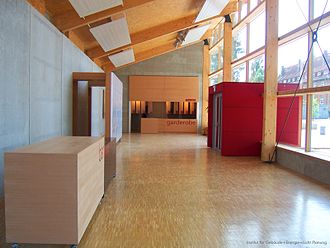Wismar Theater
The Wismar Theater is located on the premises of the Hochschule Wismar - University of Applied Sciences Technology, Business and Design - on Phillip-Müller-Straße in the Hanseatic city of Wismar .
history
On October 2, 1842, the original theater was built on Mecklenburger Strasse based on a design by the Wismar master builder Heinrich Thormann . It opened with the drama The Son of the Wild by Friedrich Halm . In 1860, Albert Ellmenreich , the director of Rostock's city theater, was granted the concession for 40 performances. This was followed by a change of directors of the theater in quick succession.
Knapp-Girard stood out particularly among them. He headed the theater from 1880 to 1901. He was followed by the theater director Hans Polte and the artists Hans Albers and Barsch, through whom the theater experienced an upswing. From 1918 to 1925 Nowakowski took over the management of the theater, which committed the Mecklenburg State Theater to a contract for 50 performances a year.
The theater experienced a heyday after the Second World War. As the first director after 1945, Peter-Christian Will built his own ensemble and filled the old theater with new life. On the night of January 9, 1948, the theater burned down to the ground due to a defective light pipe. That was the temporary end of the theater until the start of the new building on February 10, 1948. The new building was only made possible by state funds and a high level of donor response. The new theater was built from an old infantry barracks, as it can still be found today. The design came from Leo Einzig.
Intendant Hanns Anselm Perten ran the theater from 1950 to 1952 . He was not only a great promoter of drama, but also one of the initiators of the Rügen Festival at that time. As a national prize winner, he directed the ballad Klaus Störtebeker by national prize winner Kurt Barthel . The Wismar people's love for the theater can be seen in the number of visitors. In the years 1954 to 1955 alone, around 201,019 people visited the theater. In 1954 and 1955, a festival program for the 725th anniversary was created under the director Heinz Bornmann.
In 1962 the Wismar theater company began to dissolve. 1962/1963 was the last season for the Wismar multi-discipline ensemble. After the dissolution of the ensemble, the Schwerin era began. The Wismar Theater has now been taken over by the Schwerin State Theater, under the direction of Professor Hellberg as a second house. In the following summer break, the lighting systems were modernized to prevent another tragedy. The old wooden folding chairs were replaced by padded seats.
As part of the Wismar University 2020 concept, the Wismar Theater has been converted into Germany's first passive house theater since 2007 . The energy costs for operation are to be reduced by a quarter. The building project is planned and carried out by the Institute for Buildings + Energy + Light Planning Wismar.
In April 2008 the new foyer of the theater was inaugurated.
Low German stage
At the beginning of the 20th century there were only Low German clubs in Wismar. After members of the Low German Association had performed the play De Zwei Babendieks at a folk festival in Wismar in 1925 , the proposal was made to open a Volksbühne in Wismar.
The first founders' meeting took place on September 7, 1925. Max Breuel was declared the first "helmsman". He chose Heinrich Behnken's De Verschriewung as his first play . From 1927 to 1930 Willi Dethloff took over the management and under him the Low German stage gained great prestige.
literature
- Jürgen Borchert : What I know about Wismar. Hinstorff, Rostock 2000, ISBN 3-356-00875-7 .
- Leo Martens: Wismar theater history through the centuries. In: Festschrift for the 725th anniversary of the city of Wismar. Schweriner Volkszeitung, Schwerin 1954, OCLC 614686669 .
- Ulf Manhenke: 50 years of theater in the Hanseatic city of Wismar.
- Christian Roedig: Storms of applause, cheers and laurel wreaths. Wismar's theatrical life from the German Empire to the Weimar Republic . Callidus, Wismar 2015, ISBN 978-3-940677-76-1 .

